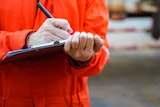Most companies today understand the need to go mobile, but beyond buying the latest software, few have a real understanding of what going mobile actually means. The plan is to have a workforce freed from their desks by having the ability to interact with technology on the go, increasing efficiency and productivity by sizeable amounts. However, those seeking to implement a mobile strategy often overlook a simple, but significant problem — the “last foot.”
The “last foot” is all about how a person interacts with technology, like a tablet, in the last foot of space (how they carry it). Specifically, what we are talking about is the ergonomics of carrying technology. Ergonomics is defined as “the study of people's efficiency in their working environment.” While there is no doubt that mobile technology is crucial for any business trying to streamline its efficiency, the ergonomics involved with carrying mobile devices needed to access this technology creates new problems that are often overlooked before implementation.
Two Hands Are Better Than One
The term “hands free” is used so often it has almost lost its value. Regardless, two hands are still more productive than one and most mobile professionals engage in several tasks throughout the day that require two hands. If they are forced to carry around a tablet, they will only have the use of one, which will cut back on their ability to perform many tasks successfully. Additionally, the worker will likely put the tablet down to use both hands and leave it somewhere, or worse, drop it and break it, causing higher replacement costs and drastically dropping productivity until a replacement is secured.
Of course, there are options for carrying tablets and devices, but most traditional bags are bulky and cumbersome and do not work well in the field. Of additional consideration is the time it takes to access these devices from these traditional bags, which on average is around 5-12 seconds. As most mobile professionals accessing their devices 50-100 times a day, these numbers begin to add up. While it may mean only a couple of wasted minutes fumbling for one user, when you are talking about an entire workforce, you can be looking at hundreds of hours wasted daily simply fumbling for devices.
Wearable Technology
Wearable technology once seemed like the answer to all of these issues, but that technology has stumbled out of the gate. Even though some wearables found success in the consumer space, it is unlikely they will realize great success in the industrial field as there is simply not enough screen space to handle what most jobs require. Imagine the level of eye strain that would be caused by looking at a watch to review building diagrams. This is why companies like Apple are making larger tablets.
Fortunately, there is a very valuable takeaway from wearable tech craze that is valid with regard to mobility — device access time. Thad Starner, who was the lead tech for Google Glass called it the “Magic Two-Second Rule” which means that if you can’t access your device in less than two seconds, your use for the device goes exponentially down. That’s why using a backpack or bag decreases productivity — it simply wastes time.
Being hands free and being able to access your device quickly is what the “last foot” of mobility is all about. Think of it like this: a carpenter needs to use his hammer throughout the day, but he’s only using it during certain times. You’re not going to see him walk around the job site with a hammer in his hands when he’s not using it. He puts it in the tool belt he wears around his waist. This is the original “wearable” technology.
Modern Solutions
Since the dawn of time, the most proven method for carrying tools has been around our waist. Whether it was a sword, pistol, or hammer, humans have always carried their tools around their waists. These days, tablets are our go-to tools for field service mobility and it still makes sense for them to be worn around the waist. If you’re planning a mobile implementation, do more than just find software solutions for your specific needs - make sure you consider solutions for the “last foot” so your workforce can get the best out of mobility.
Andrew Hamra is the CEO of RUNNUR. He pioneered and developed the RUNNUR product line in effort to improve how people and workforces interact with technology outside of the office. His understanding of ergonomics and how carrying devices long term affects the body stemmed from his years training as a manual therapist and studying body mechanics. RUNNUR fulfills his passion for creating efficiency in the workforce and the human body. Andrew is also an avid surfer and stone sculptor.





















